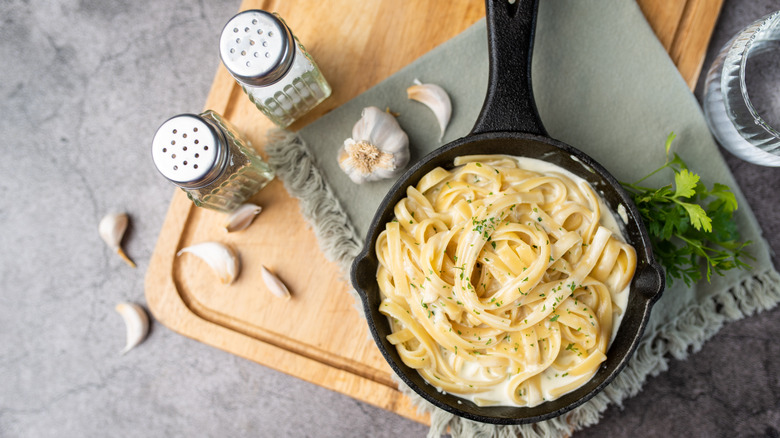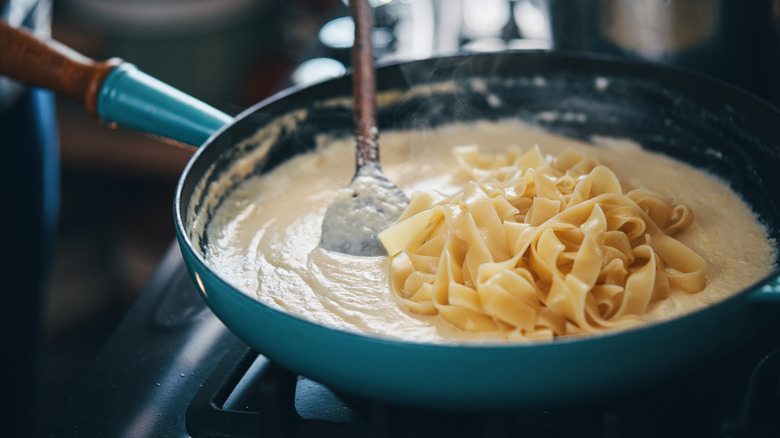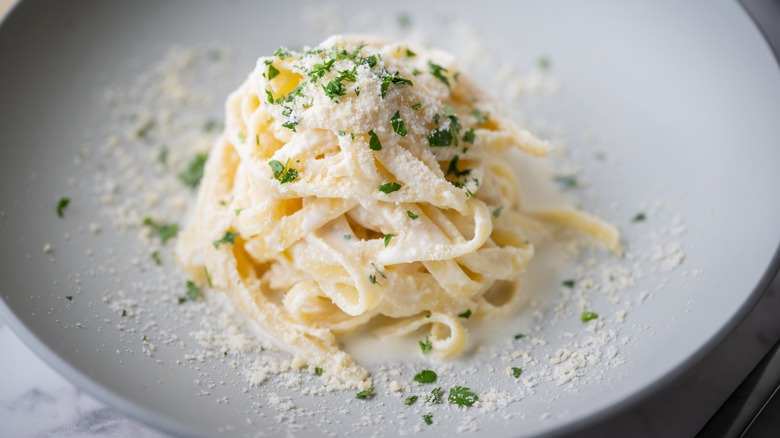The Easy Flour Trick To Prevent Thin Alfredo Sauce
Alfredo sauce is one of those staple Italian dishes that, while available widely on Italian-American restaurant menus, has actually been modified since its inception in Italy. If making it at home, you can buy jarred Alfredo sauce, but the homemade version will almost always be better.
When Alfredo sauce is made with heavy cream, the sauce usually thickens nicely as it cooks. But the sauce can be made with other dairy products, such as light cream or half and half, and when these are used, it sometimes creates a sauce that's too thin. The trick is to add a small amount of flour, which will act as a natural thickener to create that creamy, indulgent sauce.
This classic dish started as a combination of butter and Parmesan cheese initially invented by Alfredo di Lelio for his wife in Rome after she gave birth and didn't have much of an appetite. But over time, as the dish migrated to the United States, Americans started adding cream after a U.S.-based pasta company printed an Alfredo recipe involving cream right on its pasta box.
Next time you're whipping up some Alfredo sauce and find that it's thinner than it should be, add a little flour. But there is a right way to do this to make sure the flour blends smoothly and cooks completely.
Why does flour thicken Alfredo sauce?
Flour is a powdered substance made from finely ground grains — this means it includes plenty of starch. Starch molecules break apart when they're heated, which allows each of those individual molecules to bond to water molecules. When this happens, the starch molecules essentially absorb and trap those water molecules, removing moisture from the environment.
When you have a sauce that's too watery, the starch within the flour takes care of business by absorbing that excess water, leaving you with a thicker sauce in much less time than it would have taken for the sauce to reduce. Heavy cream is about 57% water, so you might not need any flour if using it in Alfredo sauce. But light cream is 74% water and half-and-half is 80% water, so you might have to add a little flour to the mix if you're preparing the sauce with either.
There is a right way to add flour to Alfredo sauce
When adding flour to a sauce, you never want to add it directly into the mix; always create a roux first. A roux is a combination of equal parts flour and fat (often butter), which are heated together to create a paste-like substance. This is important because when the two are combined, those fat molecules coat the starch molecules, preventing the starch from sticking together. This combination helps prevent flour clumps in your sauce, creating a smoother finished product. When making Alfredo sauce, you should start with the roux, then add the additional cream and cheese.
It's also important to make sure the flour cooks thoroughly. Flour can hide nasty germs, including salmonella and E. coli because there is potential for bacteria to infiltrate the wheat while it grows. Since the flour isn't heat-treated, those germs could still be present when it reaches your pantry. Thankfully, flour cooks pretty quickly, so you only need between three and five minutes of additional cooking time to get rid of that raw taste and illness risk. If you create a roux first but find that it hasn't thickened the sauce enough, try creating another small amount of roux in a separate pan or dish rather than adding flour directly to the sauce.


